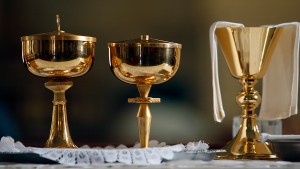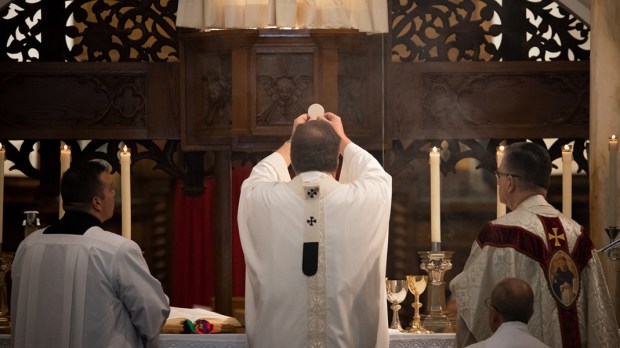Even if we love the Mass, the repetition of the ritual, day (or week) in and day (or week) out can lead to a feeling of boredom. Some Catholics have even left the Church in order to participate in the “livelier” and more emotive worship services of certain Protestant communities.
But Catholics continue to value the ritual of our Mass. If we understand the liturgy, we can begin to understand why.
A ritual is a fixed and repeatable form of worship, and it is at the center of Catholicism because it reminds us that, in the words of Joseph Ratzinger, when it comes to God and faith, “we ourselves do not manufacture but receive as a gift.”
To be sure, no human-generated creation or expression of emotion can come close to the power and sublimity of the Catholic Mass, which is a gift received from Christ Himself for the specific purpose of supplying us with the most perfect way to honor God.
Faith exists because God initiates a relationship with us; it is fitting, then, that God also initiated the form of worship He desires from us through the Eucharistic self-sacrifice of the Last Supper and on the cross offered by His Son. Human emotion is then born in awe and in humble gratitude at so great a gift.
Faith exists because God initiates a relationship with us; it is fitting, then, that God also initiated the form of worship He desires from us …
The Mass, as well as the other liturgical traditions of the sacraments and the divine office, have grown directly from the ministry of Christ and His apostles. Specific forms and words have varied through the centuries, but, regardless of location and language, the essence of each liturgical celebration has remained constant, and each one brings us back to the very source of our faith.
Hence Ratzinger explains that liturgical rites “elude control by any individual, local community, or regional Church. Unspontaneity is of their essence. In these rites I discover that something is approaching me here that I did not produce myself, that I am entering into something greater than myself, which ultimately derives from divine revelation.”
Unspontaneity is of their essence.
The decision to enter into Catholic liturgy illuminates both the role of sentiment in worship and the role of the individual worshiper within the Church. Romano Guardini teaches that prayer “is, without a doubt, ‘a raising of the heart to God.’ But the heart must be guided, supported, and purified by the mind … Prayer is beneficial only when it rests on the bedrock of truth.”
Just as assent takes priority over sentiment in the life of faith, worship and prayer, which are the ways we express and manifest our faith in God, follow the same order.
This is not to say that sentiment does not have a place in the liturgy, for, as Guardini adds, the “Church’s worship is full of deep feeling, of emotion that is intense, and sometimes even vehement … But as a rule it is controlled and subdued. The heart speaks powerfully, but thought at once takes the lead.”

Read more:
How the chalice and burial of Jesus are connected
As the liturgy repeats most of the same words day after day, year after year, century after century, this subdued emotion strikes us in different ways, sometimes gently, and sometimes not at all.
But it is not emotion that constitutes the liturgy: it is the action of God Himself, and our commitment to Him, rather than our feelings for Him, that form the heart of the liturgy.
Guardini reminds us that “liturgy is no mere commemoration of what once existed, but is living and real; it is the enduring life of Jesus Christ in us, and that of the believer in Christ, eternally God and Man.”
In baptism Christ made us part of His Body, the Church, so through the liturgy we encounter the living God together, not as individual entities, but as individual members of the one Body. The individual, continues Guardini, must desire to be part of this body, and being so requires an act of humility on his part: “he must lay self aside, and live with, and for, others, sacrificing to the community a proportion of his self-sufficiency and independence.”
This act of self-sacrifice enables the individual to transcend his own limits in being part of something greater. And “in doing so he is not swallowed up by, and lost in, the majority; on the contrary, he becomes more independent, rich, and versatile” because the believer comes into closer contact with the source of life itself on God’s terms rather than his own. To pray as a member of the Church is to fulfill the promise of Jesus: “whoever exalts himself will be humbled, and whoever humbles himself will be exalted” (Matt. 23:12).
To be a strong and helpful member of the body of Christ, the individual must both participate in liturgical prayer by attending Mass each Sunday and pray privately on her own. Personal prayer is our free conversation with God, by which we live out and develop our relationship with Him. The Second Vatican Council teaches that personal prayer is nourished by liturgical prayer because the latter directs the believer to the heart of the mystery of faith: Christ’s passion, death, resurrection, and ascension, referred to collectively as the Paschal Mystery.
The Church’s treasury of prayers, including the Our Father, Hail Mary, and the many others we have learned by rote, also are important because they tie our personal prayer—our subjective faith—back to the objective faith of the Church.
Hence, in addition to nourishing our faith, liturgical prayer prevents our prayer and our faith from collapsing in on ourselves. As Guardini candidly puts it, “[i]t is only truth—or dogma, to give it its other name—which can make prayer efficacious, and impregnate it with that austere, protective strength without which it degenerates into weakness … Dogmatic thought brings release from the thralldom of individual caprice, and from the uncertainty and sluggishness which follow in the wake of emotion. It makes prayer intelligible, and causes it to rank as a potent factor in life.”
In practice, liturgical and ritual prayer carry the danger of becoming external actions empty of meaning. But we must also guard against the tendency to deem ritual empty simply because it is ritual. The presence or absence of feeling felt during these rituals is of secondary importance to our assent to their truth and to our decision to partake of them to the best of our abilities. The true joy and excitement of ritual lies not in our reaction to its performance, but in our understanding of what these rituals are and what they convey.

Read more:
Why do we name Pontius Pilate in the Creed at Mass?
~
David G. Bonagura, Jr. teaches at St. Joseph’s Seminary, New York. He is the author of Steadfast in Faith: Catholicism and the Challenges of Secularism (Cluny Media), from which this article is adapted.

